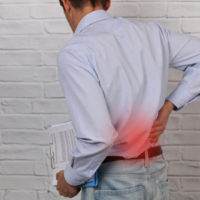Why Does My Neck and Back Hurt After My Car Accident?

Car accidents can be devastating to one’s spine and neck health. The spine and neck joints and muscles are critical to a person’s ability to move, and they are extremely sensitive to sudden force. When a vehicle crashes into another moving or inanimate object, the sedentary state of the rival force causes everything in the vehicle—including one’s body—to jolt forward as a result. However, due to the safety restraint and the small amount of space in any given cab, the body is forced to come to a sudden stop almost immediately after being jolted forward, causing a significant amount of pressure on the neck and back. This jolting motion is commonly known as whiplash, and in addition to severe discomfort and pain, it can result in long-term or even lifelong injuries to the spine. For the sake of this article, we will discuss two of the most common types of neck and back injuries: disc injuries and facet joint injuries.
Discogenic Pain (Disc Injuries)
Cartilage separate the discs that make up the spine and cushion them from one another to allow for easy and pain free movement. When that cartilage becomes damaged, the pain can be immense and even debilitating, as without that necessary cartilage, the bones grind up against one another instead of moving fluidly with one another. This type of pain is referred to as discogenic pain.
Discogenic pain can occur in one of two ways: over time and as the result of the gradual deterioration of one’s spinal discs or suddenly and as the result of sudden distress, such as in a car accident. Typically, victims of car accidents experience discogenic pain in the lower region of the spine. Their pain typically stems from one or more of the following types of injuries:
- Spinal Stenosis;
- Lumbar Sprains; and
- Disc Herniation.
Discogenic pain can come one at any point and is highly uncomfortable. When bad enough, it can prevent a car accident victim from performing normal activities such as bending, sitting, walking, or standing. The pain may start in the back but often shoots down into the buttocks, groin, both legs, and into the feet.
Facet Injuries
Facet joints are the joints in one’s spine that allow it to move freely. It does this by secreting a gelatinous fluid that acts as a lubricant for the joints. The main role of these joints is to allow for strong and controlled movements, or to keep the spine from moving too much in one direction or the other. In order to do its job properly, it relies on an abundance of nerves, the endings of which all meet in the facet joints. It is because this excessive amount of nerve endings that a person experiences extreme pain when the facet joints are damaged.
Common symptoms of facet joint damage include:
- Muscle Spasms;
- Misalignment;
- Facet Locking Syndrome; and
- Difficulty Moving.
Facet joint damage often leads to discogenic pain, make a person’s back injuries extra insufferable.
Let a Miami Car Accident Lawyer Fight for the Compensation You Need to Recover Peacefully
Lower back pain is the leading cause of disability worldwide, is the most common reason for missed work, and is responsible for at least $50 billion in medical spend in the U.S. alone each year. Back pain is no joke. If you suffer from severe back pain post-accident, do not write it off as “inevitable” or a “result of your lifestyle.” There is a very real chance that your back pain is due to your car accident, and if it is, you deserve to be compensated for your injuries and the monetary losses it has caused you.
Proving back pain can be a pain (pun intended), and without an aggressive car accident lawyer on your side, there is a very real possibility that the insurance company will deny your claim for compensation. An experienced attorney can provide all the proof necessary to show that your pain did, in fact, stem from the accident, and that you would be in perfectly good health otherwise. If you want to be fairly compensated for your back injuries, do not wait, and contact the skilled Miami car accident lawyers at Spencer Morgan Law today.
Resource:
acatoday.org/Patients/Health-Wellness-Information/Back-Pain-Facts-and-Statistics
